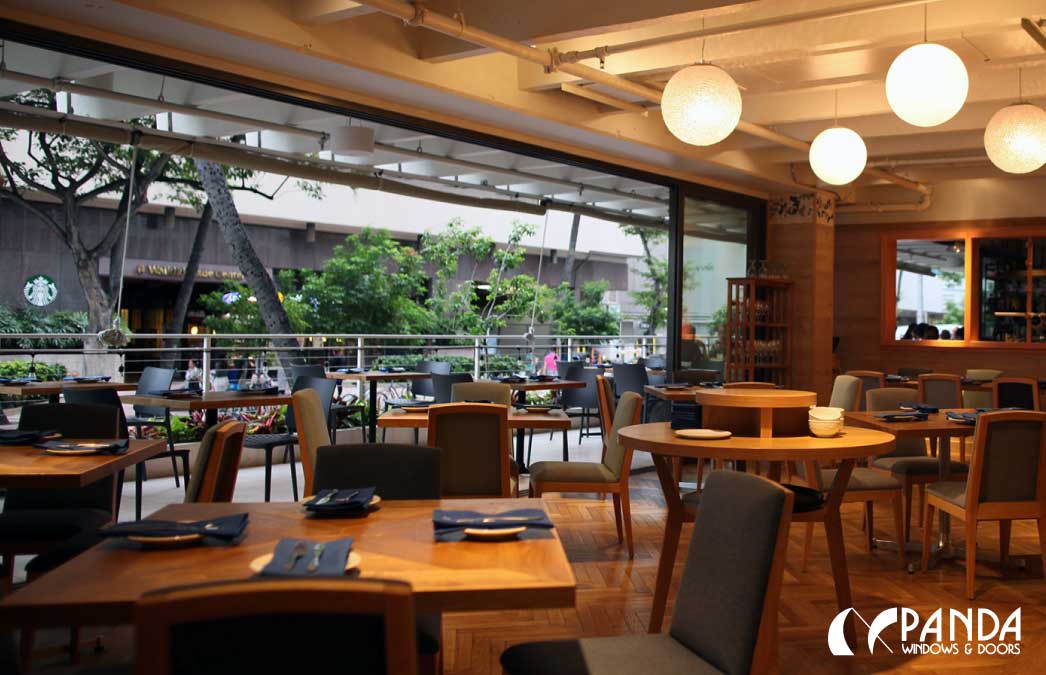Gas-Filled Glass vs Double-Glazed Glass: Which Is Better?
October 2, 2024
Key Takeaways
- Gas-filled glass uses inert gasses like argon for better insulation and energy efficiency.
- Double-glazed glass consists of two panes of glass with a space in between for good energy savings and noise reduction – and this space can be filled with just air or inert gasses.
- Both options provide better insulation than single-pane windows, but gas-filled glass generally offers superior thermal performance than air-filled double-glazed glass.
- Double-glazed windows are more widely available and can be more cost-effective upfront, but may not provide the same level of insulation as gas-filled windows.
- At Panda Windows & Doors, we can help you choose the right type of glass depending on your specific needs, including climate, budget, and energy efficiency goals.
What is Gas-Filled Glass
Gas-filled glass is a type of insulated glass unit (IGU) that enhances thermal performance. The space between the glass panes is hermetically sealed and filled with gas. This gas layer acts as an insulator, reducing the amount of heat that passes through the window. It’s a simple yet effective way to boost the energy efficiency of your home.
The inert gasses used in these windows are colorless, odorless, and non-toxic, making them safe for use in residential settings. They work by slowing down the transfer of heat through the window, which keeps your home warmer in the winter and cooler in the summer.
- Argon Gas: This is the most commonly used gas, known for its excellent thermal insulation and cost-effectiveness.
- Krypton Gas: Although more expensive, krypton provides even better insulation and is often used in triple-glazed or very thin double-glazed units.
- Xenon Gas: Denser than krypton and argon, xenon has excellent insulation which makes it perfect for large commercial buildings and specialized applications. Since it’s the most expensive inter gas, it’s rarely used in domestic applications.

Here’s how gas-filled glass works (image courtesy of Cosyhomes Windows).
Advantages of Gas-Filled Glass
- Improved Energy Efficiency: The gas fill acts as an insulator, reducing the U-factor (the rate at which a window conducts non-solar heat flow) and helping to lower your energy bills.
- Reduced Condensation: This glass type is less likely to have condensation on the inside, as the gas reduces the potential for moisture build-up.
- Enhanced Comfort: By minimizing heat transfer, this glass helps maintain consistent indoor temperatures, enhancing comfort.
- Sound Insulation: The use of gas-filled glass can contribute to a quieter space by providing a buffer against outside noise—a significant advantage for urban dwellers.
Disadvantages of Gas-Filled Glass
- Cost: They can be more expensive than air-filled double-glazed glass due to the specialized manufacturing process.
- Potential for Leakage: Over time, the gas can slowly leak out, reducing the insulating properties of the glass. However, high-quality ones are designed to minimize this risk.
- Availability: Not all manufacturers offer gas-filled options, so you may have fewer choices compared to double-glazed glass.
|
Founded in 1991, Panda Windows & Doors specializes in state-of-the-art custom glass wall systems for both residential and commercial spaces through Panda Windows & Doors. Operating from our manufacturing facility in Las Vegas, Nevada, we have been at the forefront of innovation for over 30 years. Our extensive product lineup includes over 80 high-end offerings, such as pivot doors, French doors, folding doors, lift & slides, multi-slides, horizontal sliding walls, and operable windows. These systems are available in materials like aluminum, steel, stainless steel, bronze, solid wood, and aluminum-wood clad. We are renowned for our award-winning designs, engineering solutions, and fast lead times, delivering in just 6-10 weeks to customers throughout the U.S. and Caribbean. Trusted by leading architectural firms and glaziers nationwide, we stand as the premier manufacturer of custom luxury windows and doors in the United States. |
What is Double-Glazed Glass
Also known as double-pane glass, double-glazed glass consists of two panes of glass separated by a sealed air or gas-filled space. This gas-filled space acts as an effective thermal barrier, reducing heat transfer through the window compared to regular single-pane windows.
If the space is just filled with air or even dehydrated air (dry air with low humidity levels), the glass won’t work as effectively as gas-filled glass to insulate against heat and noise.

Here’s how a double-glazed glass looks (image courtesy of The Spruce).
Advantages of Double-Glazed Glass
Double-glazed glass usually has the same advantages as gas-filled glass if the space in between the panes is filled with inert gasses.
Disadvantages of Double-Glazed Glass
One of the main drawbacks is that they may not provide as much insulation as gas-filled windows – especially if they are just filled with air or dehydrated air. This can be a concern in extreme climates where maintaining a consistent indoor temperature is crucial.
If the seal on a double-glazed glass fails, it can lead to condensation between the panes, which obstructs the view and also reduces the insulating properties. Repairing this issue often requires replacing the entire glazed unit.
Gas-Filled Glass vs Double-Glazed Glass
Energy Efficiency
Well-insulated glass can significantly reduce the need for heating and cooling, leading to lower energy bills.
Gas-filled glass is superior in this regard, as the inert gas provides better insulation than the air in double-glazed windows. However, double-glazed glass still has a marked improvement over single-pane glass and is a cost-effective option for those looking to upgrade without breaking the bank.
Cost Considerations
Air-filled double-glazed glass is typically less expensive than its gas-filled counterparts. The initial investment for double-glazing can be significantly lower, making it an attractive option for homeowners on a tight budget.
But while gas-filled glass may cost more upfront, the energy savings over time can offset the initial expense. It’s a balance between immediate cost and future savings.
Installation and Maintenance
Both types of glass require professional installation to make sure they perform effectively. Double-glazed glass is more common and most installers will be familiar with them, potentially making the installation process quicker and easier. Gas-filled glass windows and doors may require specialists, particularly if you’re opting for higher-end gasses like krypton or xenon. Maintenance for both is relatively similar, though gas-filled windows may need checks for gas leaks.
Both gas-filled and double-glazed glass can last for many years if properly maintained. However, the performance of gas-filled windows can diminish if the gas escapes, whereas double-glazed windows may suffer from seal failure, leading to condensation between the panes.
Aesthetic and Practical Considerations
Aesthetically, both gas-filled and double-glazed glasses are available in a variety of styles to suit your home’s design. Practically speaking, both types reduce heat transfer, which can help to prevent fading of furniture and carpets due to sunlight exposure. They also both offer sound reduction, which is a boon in noisy urban environments.
Ideal Uses for Each Glass Type
Best Situations for Gas-Filled Glass
- Homes in regions with extreme temperatures, where superior insulation is necessary.
- Spaces where maximizing energy efficiency for long-term savings is a priority.
- Rooms that require consistent temperatures for comfort, such as bedrooms and living areas.
- High-rise urban apartments where external noise and temperature extremes are common.
Best Situations for Double-Glazed Glass
- Homeowners looking for a balance between improved insulation and affordability.
- Renovation projects where the budget is a concern but energy efficiency is still a goal.
- Areas where moderate climate conditions don’t necessitate the highest level of insulation.
- They are also a great choice for rental properties where the long-term investment in gas-filled windows may not be justified.
|
Comparison |
Gas-Filled Glass |
Double-Glazed Glass |
|
Energy Efficiency |
– Provides better thermal insulation than regular air-filled double-glazed windows due to the lower thermal conductivity of the gasses (argon, krypton) – Krypton is denser, more effective and more expensive than argon |
– Can achieve excellent energy efficiency, especially when configured with low-e coatings – The type of gas used (argon vs. krypton) affects the insulating properties |
|
Cost Considerations |
– More expensive than regular double-glazed windows due to the cost of the inert gasses and specialized manufacturing – The higher initial cost may be offset by long-term energy savings |
– Can be a more cost-effective option compared to gas-filled glass, especially for larger window areas |
|
Installation and Maintenance |
– Requires proper installation to ensure an airtight seal to maintain insulating properties – If the seal fails, the gas can leak out, reducing performance. Repairing a failed seal is difficult. |
– Also requires proper installation for airtight seals – Easier to repair if the seal fails, as individual glass panes can be replaced without replacing the entire window frame |
|
Aesthetic and Practical Considerations |
– Similar appearance to double-glazed windows, with two or more panes of glass separated by a spacer – Provides enhanced soundproofing compared to single-pane windows |
– May be more suitable for older homes or traditional architectural styles, as they can be made to match existing windows more closely – Can trap heat during summer months, potentially leading to discomfort |
|
Best Situations to Use |
– Locations with predominantly cold weather – Homes where acoustic insulation is a priority – Areas with high energy costs |
– Regions with high temperature fluctuations – Homes where UV protection is important – Locations with a mix of hot and cold climates |
Table comparing the characteristics of gas-filled glass and double-glazed glass.
Making the Right Choice with Panda Windows & Doors
At Panda Windows & Doors, we understand that choosing the right glass is about more than just aesthetics – it’s about creating a comfortable, energy-efficient space.
Our experts are here to guide you through the selection process, ensuring you get glass solutions that look great and perform to your expectations. We’ll consider factors like your local climate, the architectural style of your project, and your energy efficiency goals to recommend the best solution for you.
Choosing the right glass is also about ensuring they last – that’s why we back our high-quality window systems with robust warranties. Gas-filled glass and double-glazed glass both have long lifespans when installed and maintained correctly. In addition to the seals, we use advanced technology to minimize the risk of leakage and maximize the lifespan of your glass windows and doors.
Contact us to learn more about our gas-filled glass and double-glazed for your custom doors and windows.
Frequently Asked Questions (FAQ)
How Do I Know Which Glass Type is Right for My Climate?
The right glass type for your climate depends on the temperature extremes you experience. Gas-filled glass is particularly effective in very cold or very hot climates due to its superior insulating properties. If you live in a moderate climate, double-glazed windows can provide adequate insulation and energy efficiency. Our team can help you assess your specific needs based on your local climate conditions.
Can I Upgrade Single-Glazed Windows to Gas-Filled or Double-Glazed?
Yes, you can upgrade from single-glazed windows to either gas-filled or double-glazed windows. Upgrading will significantly improve your home’s thermal performance and energy efficiency. Keep in mind that this will involve replacing the entire window unit, but it’s a worthwhile investment for the benefits you’ll gain.
Are Gas-Filled Windows More Expensive than Double-Glazed?
Generally, gas-filled windows are more expensive than double-glazed windows due to the specialized technology and gasses used. However, the cost difference can be offset by the energy savings and increased comfort over time.
What Is the Lifespan of Gas-Filled and Double-Glazed Windows?
Both gas-filled and double-glazed windows can last for many years—often several decades—with proper installation and maintenance.
The longevity of gas-filled windows can be affected by gas leakage, while double-glazed windows may experience seal failure. However, with quality products and installation, these issues can be minimized – guaranteeing a long lifespan for your windows.
How Does Window Glass Impact Energy Bills?
Window glass can have a significant impact on your energy bills. Poorly insulated windows can lead to heat loss in the winter and heat gain in the summer, causing your heating and cooling systems to work harder.
Both gas-filled and double-glazed windows provide better insulation than single-pane windows, reducing the amount of energy needed to maintain comfortable indoor temperatures and, consequently, lowering your energy bills.

NanaWall vs Andersen vs Panda Doors and Windows | Costs & Features
Compare NanaWall, Andersen, and Panda doors and windows, examining their costs and features to help you choose the best fit for your home in this detailed guide.

NanaWall vs Pella vs Panda | Door & Window Costs & Features
Compare NanaWall, Pella, and Panda doors and windows, exploring costs and features to help you choose the best option for your home in this guide.

Gas-Filled Glass vs Tempered Glass: Which Is Better?
Discover the differences between gas-filled glass and tempered glass to decide which is better for your building needs in our guide.











